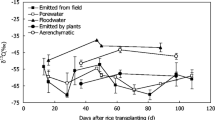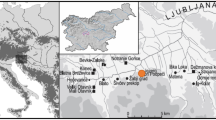Abstract
Isotopic compositions of CH4 and CO2 surface and subsurface gases and groundwater from an urban solid waste disposal site from Gualeguaychú city (Argentina) were measured to detect origin, depth distribution, migration lateral, CH4 oxidation, and dissolution in groundwater. The highest CH4 concentrations (60–88 %) with δ13C-CH4 (between −60 and −45 ‰) and δ2H-CH4 (between −350 and −260 ‰) were attributed to CH4 originated by microbial sources, v. gr. acetate fermentation. The δ13C-CO2 related to this CH4 (between −15 and −5.9 ‰) were compatible with this process. Also, the increase of DIC associated to an increase in δ13C-DIC values (−12.4, −6.4, −5.8, −1.5, +0.1 and +4 ‰) indicated the transport of dissolved gases (from methanogenesis) in the groundwater flow system. High excess deuterium in 3 piezometers suggests that there were hydrogen isotope exchange between CH4 and water too. Evidences for CH4 oxidation were decrease in CH4 concentrations, shift in C and H isotope ratios of CH4 to more enriched in the remaining CH4 (in both, δ13C-CH4 >−50 ‰ and δ2H >−260 ‰) and depletion in 13C of the associated CO2 (<−20 ‰). Since surface CH4 and CO2 concentrations over the covering layer were very low, and the major CH4 concentrations were found between 60m and 90 cm depth, it is very probable USW has been compacted with low permeability materials (e.g., clay) avoiding large emissions to the atmosphere and creating horizontal barriers within the waste that enable lateral gas migration. Horizontally, it can be seen that these gases migrated outside the disposal site following the topography and that CH4 disappeared leading to anomalous concentrations of CO2 whose values are greater than those produced by normal soil respiration. The isotopic value (δ13C) of this CO2 was also different from that of normal soil respiration (~−25 ‰) and reflected effects that generated isotopic depletion by diffusion (~−25 to −32 ‰). The analysis of C isotopes as the main tracer, together H isotopes, has allowed the effective detection of the origin and those secondary processes.









Similar content being viewed by others
References
ATSDR (2001) Agency for toxic substances and disease registry. Landfill gas primer—an overview for environmental health professionals. http://www.atsdr.cdc.gov/HAC/landfill/html/intro.html
Barlaz MA, Green RB, Chanton JP, Goldsmith CD, Hater GR (2004) Evaluation of a biologically active cover for mitigation of landfill gas emissions. Environ Sci Technol 38:4891–4899
Bergamaschi P (1997) Seasonal variations of stable hydrogen and carbon isotope ratios in methane from a Chinese rice paddy. J Geophys Res 102(D21):25383–25393
Bjerg PL, Albrechtsen HJ, Kjeldsen P, Christensen TH (2005) The groundwater geochemistry of waste disposal facilities. In: Sherwood Lollar B (ed) Environmental geochemistry Vol. 9. Treatise on geochemistry. Elsevier–Pergamon, Oxford, pp 579–612
Bogner J, Pipatti R, Hashimoto S, Diaz C, Mareckova K, Diaz L, Kjeldsen P, Monni S, Faaij A, Gao Q (2008) Mitigation of global greenhouse gas emissions from waste: conclusions and strategies from the intergovernmental panel on climate change (IPCC). Fourth assessment report. Working group III (Mitigation). Waste Manag Res 26:11–32
Boujon P, Sanci R (2014) Evaluación de la vulnerabilidad del acuífero libre en la cuenca del Arroyo El Cura, Gualeguaychú. Entre Ríos Rev Asoc Geol Arg 71(2):274–289
Castañeda SS, Sucgang RJ, Almoneda RV, Mendoza ND, David CPC (2012) Environmental isotopes and major ions for tracing leachate contamination from a municipal landfill in Metro Manila, Philippines. J Environ Radioact 110:30–37
Cerling TE, Solomon DK, Quade JB, John R (1991) On the isotopic composition of carbon in soil carbon dioxide. Geochim Cosmochim Acta 55(11):3403–3405
Chanton LC, Chasar P, Glaser D, Siegel (2005) Carbon and hydrogen isotopic effects in microbial methane from terrestrial environments. In: Flanagan LB, Ehleringer JR, Pataki DE (eds) Stable isotopes and biosphere–atmosphere interactions, physiological ecology series. Elsevier–Academic Press, Amsterdam, pp 85–105 Chapter 6
Christophersen M, Kjeldsen P (2001) Lateral gas transport in soil adjacent to an old landfill: factors governing gas migration. Waste Manage Res 19:144–159
Clark ID, Fritz M (1997) Tracing the carbon cycle. In: Environmental isotopes in hydrogeology, Lewis Publishers, New York, pp 111–136
Coleman DD, Risatti BJ, Schoell M (1981) Fraction of carbon and hydrogen isotopes by methane oxidizing bacteria. Geochim Cosmochim Acta 45:1033–1037
Coleman DD, Liu CL, Hacley KC, Benson LJ (1993) Identification of landfill methane using carbon and hydrogen isotope analysis. In: Proceedings of 16th international madison waste conference, municipal & industrial waste, Department of Engineering Professional Development, University of Wisconsin, Madison, pp 303–314
Conrad ME, Templeton AS, Daley PF, Alvarez-Cohen L (1999) Isotopic evidence for biological control on migration of petroleum hydrocarbons. Org Geochem 30:843–859
Cordero R, Panarello HO, Corvalán C, Galante G, Ostera HA (2004) Determinación experimental de 13C y 2H sobre metano. XXV Congreso Argentino de Química (resumen), Facultad de Ingeniería-UNCPBA, Olavarría, Buenos Aires
Craig H (1961) Isotopic variations in meteoric water. Science 133:1702–1703
Dapeña C, Panarello HO (2004) Composición isotópica de la lluvia de Buenos Aires. Su importancia para el estudio de los sistemas hidrológicos pampeanos. Revista Latino-Americana de Hidrogeología 4:17–25
Dapeña C, Panarello HO (2007) Estación Santa Fe. Red Nacional de Colectores, Argentina, V Congreso Argentino de Hidrogeología, Paraná, Entre Ríos, IAH Universidad Nacional de Entre Ríos, pp 187–198
De Visscher A, De Pourcq I, Chanton J (2004) Isotope fractionation effects by diffusion and methane oxidation in landfill cover soils. J Geophys Res 109:D18111. doi:10.1029/2004JD004857
Environment Agency UK (2010) Guidance on the management of landfill gas. http://www.environment-agency.gov.uk/business/sectors/108918.aspx#landfillgas
Gandhi H, Wiegner TN, Ostrom PH, Kaplan LA, Ostrom NE (2004) Isotopic (13C) analysis of dissolved organic carbon in stream water using an elemental analyzer coupled to a stable isotope ratio mass. Rapid Commun Mass Spectrom 18:903–906
Gat JR (2010) Isotope hydrology. A study of the water cycle. Centre for Environmental Technology. Imperial College, London, pp 70–71
Hackley KC, Liu CL, Coleman DD (1996) Environmental isotope characteristics of landfill leachates and gases. Ground Water 34(5):827–836
Hackley KC, Liu CL, Traidor D (1999) Isotopic identification of the source of methane in subsurface sediments of an area surrounded by waste disposal facilities. Appl Geochem 14:119–131
Hornibrook ERC, Longstaffe FJ, Fyfe WS (2000) Evolution of stable carbon isotope compositions for methane and carbon dioxide in freshwater wetlands and other anaerobic environments. Geochim Cosmochim Ac 64(6):1013–1027
Kerfoot HB (1994) Landfill gas effects on groundwater samples at a municipal solid waste facility. J Air Waste Manage Assoc 44:1293–1298
Kerfoot HK, Baker JA, Burt DM (2003) The use of isotopes to identify landfill gas effects on groundwater. J Environ Monit 5:896–901
Kjeldsen P, Morton A, Barlaz A, Rooker P, Baun A, Ledin A, Christensen TH (2002) Present and long-term composition of MSW landfill leachate: a review. Crit Rev Environ Sci Technol 32(4):297–336
Kumar S, Mondal AN, Gaikwad SA, Devotta S, Singh RN (2004) Qualitative assessment of methane emission inventory from municipal solid waste disposal: a case study. Atmos Environ 38:4921–4929
Lloyd J, Taylor JA (1994) On the temperature dependence of soil respiration. Funct Ecol 8:315–323
Lomond JS, Tong AZ (2011) Rapid analysis of dissolved methane, ethylene, acetylene and ethane using partition coefficients and headspace-gas chromatography. J Chromatogr Sci 49:469–475
MacCrea JM (1950) On the isotopic chemistry of carbonates and paleotemperature scale. J Chem Phys 18(6):849–857
Mahieu K, De Visscher A, Vanrolleghem PA, Van Cleemput O (2008) Modelling of stable isotope fractionation by methane oxidation and diffusion in landfill cover soils. Waste Manag 28:1535–1542
Mook WG (2000) Environmental isotopes in the hydrological cycle. In: Mook WG (ed) Principles and applications, vol I. UNESCO, Paris, pp 96–101
Panarello HO, Garcia CM, Valencia SA, Linares E (1982) Determinación de la composición isotópica del carbono en carbonatos, su utilización en Hidrogeología y Geología. Rev Asoc Geol Arg XXXV(4): 460–466
Panarello HO, Dapeña C, Ostera HA, Stöckli F (2005) Caracterización química e isotópica preliminar del Basurero Municipal de Gualeguaychú, provincia de Entre Ríos, República Argentina. IV Congreso Argentino de Hidrogeología, Río Cuarto, Universidad Nacional de Río Cuarto, 197–205
Parkhurst DL, Appelo CAJ (1999) User’s guide to PHREEQC—a computer program for speciation, batch reaction, one-dimensional transport, and inverse geochemical calculations. Water Resour Invest Rep 99-4259 US Geol Surv, Denver
Pumpanen J, Kolari P, Lvesniemi H, Minkkinen K, Vesala N, Lohila A, Larmola T, Morero M, Pihlatie M, Janssens I, Yuste JC, Gru¨nzweig JM, Reth S, Subke J, Savage K, Kutsch W, Ø ´Streng G, Ziegler W, Anthoni P, Lindroth A, Hari P (2004) Comparison of different chamber techniques for measuring soil CO2 efflux. Agric For Meteorol 123:159–176
Sanci R, Panarello HO, Ostera HA (2012) CO2 emissions from a municipal site for final disposal of solid waste in Gualeguaychu, Entre Rios Province, Argentina. Environ Earth Sci 66:519–528
SEPA (2004) Scottish environment protection agency. Guidance on the management of landfill gas. http://www.sepa.org.uk/waste/waste_regulation/landfill.aspx
Stumm W, Morgan JJ (1996) Aquatic chemistry. Environmental Science and Technology, New York, p 461
Valencio S, Ostera HA, Panarello H (2003) Monitoring 13C in CO2 soil gas from a landfill: first results from a case study. IV South American symposium on isotope geology, Short papers I: 128–130, Salvador, Brasil
Van Breukelen BM, Roling FM, Groen J, Griffioen J, Van Verseveld HW (2003) Biogeochemistry and isotope geochemistry of a landfill leachate plume. J Contam Hydrol 65:245–268
Wassenaar LI, Coplen TB, Aggarwal PK (2014) Approaches for achieving long-term accuracy and precision of δ18O and δ2H for waters analyzed using laser absorption spectrometers. Environ Sci Technol 48(2):1123–1131
Whiticar MJ (1999) Carbon and hydrogen isotope systematics of bacterial formation and oxidation of methane. Chem Geol 161:291–314
Whiticar MJ, Faber E, Schoell M (1986) Biogenic methane formation in marine and freshwater environments: CO2 reduction vs. acetate fermentation—isotope evidence. Geochim Cosmochim Acta 50:693–709
Acknowledgments
This research was supported by the Instituto de Geocronología y Geología Isotópica (UBA-CONICET) and PICT 2010 Nro. 2749. The authors are grateful to Stable Isotopes Laboratory staff members, Estela Ducos and Eduardo Llambias and Gabriel Giordarengo.
Author information
Authors and Affiliations
Corresponding author
Rights and permissions
About this article
Cite this article
Sanci, R., Panarello, H.O. Carbon stable isotopes as indicators of the origin and evolution of CO2 and CH4 in urban solid waste disposal sites and nearby areas. Environ Earth Sci 75, 294 (2016). https://doi.org/10.1007/s12665-015-4906-5
Received:
Accepted:
Published:
DOI: https://doi.org/10.1007/s12665-015-4906-5




